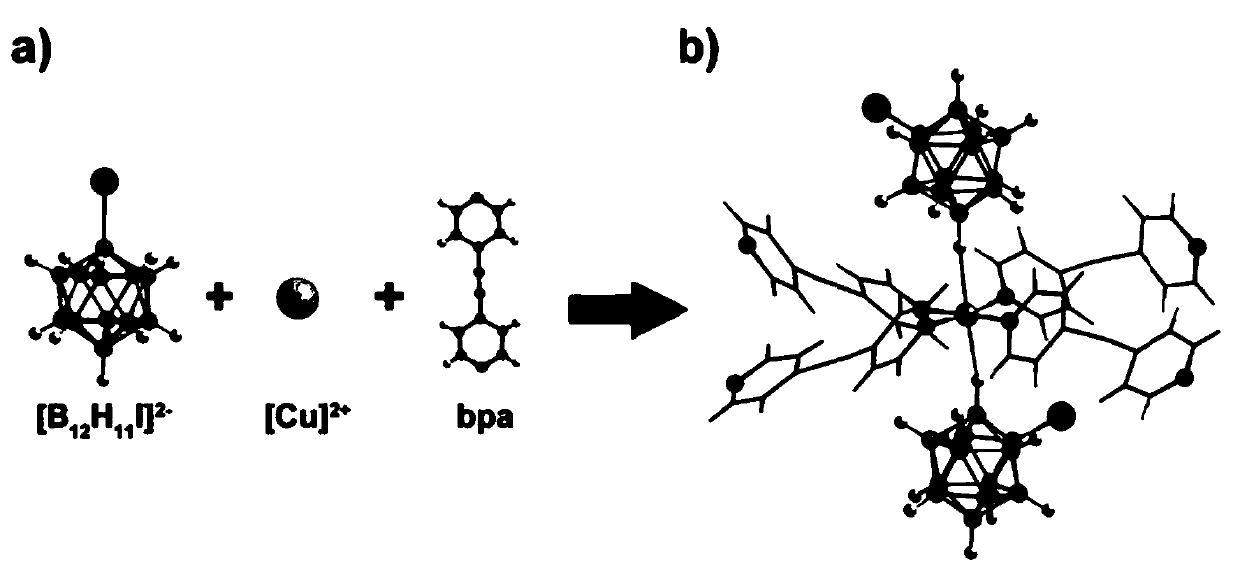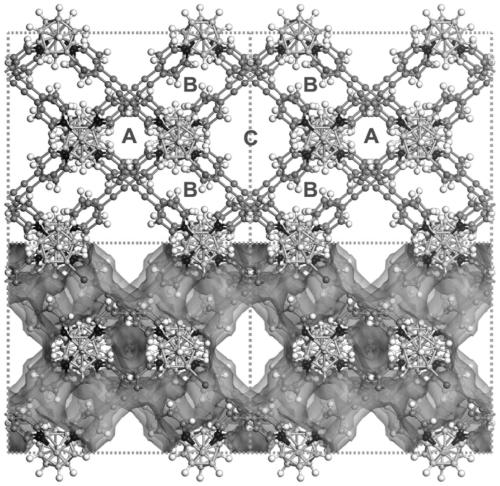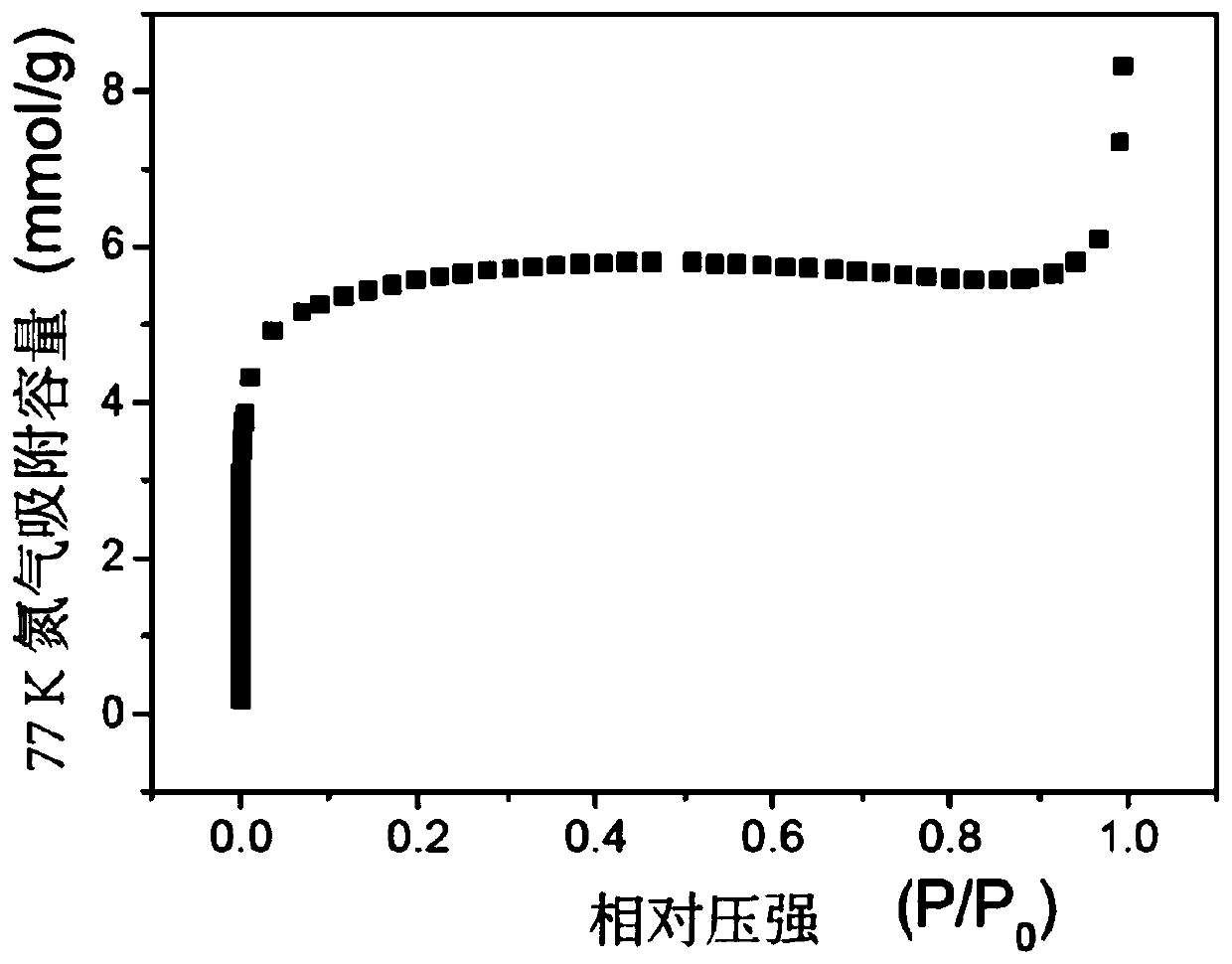Functional cage borane anion-pillared supramolecular microporous framework material, preparation method and application thereof
An anion column and frame material technology, applied in separation methods, chemical instruments and methods, adsorption purification/separation, etc., can solve problems such as applications to be studied, achieve good structural stability, and achieve the effect of selective separation
- Summary
- Abstract
- Description
- Claims
- Application Information
AI Technical Summary
Problems solved by technology
Method used
Image
Examples
Embodiment 1
[0035] In a 50mL round bottom flask, will contain 242mg (1mmol) of Cu(NO 3 ) 2 ·3H 2 O and 314 mg (1 mmol) of Na 2 B 12 h 11 I was dissolved in 10 ml of water. In another 25 mL round bottom flask, 360 mg (2 mmol) of 4,4'-bipyridylacetylene was dissolved in 15 mL of methanol. The methanol solution was slowly added to the aqueous solution, and stirred at 25°C for 24 hours to obtain a gray-purple solid precipitate, which was filtered and washed with methanol. Replace the above solid in anhydrous methanol 3 times with an interval of 12 hours each time to remove the water molecules in the pores of the material, and then degas and activate it at 70°C for 10 hours to obtain the activated functionalized caged dodecaborane anion supramolecule The microporous frame material is named BSF-20.
[0036] The self-assembly behavior of BSF-20 is as figure 1 shown. First, metallic copper ions are coordinated to four different pyridine rings in the horizontal direction and to B–H of two...
Embodiment 2
[0054] In a 50mL round bottom flask, will contain 242mg (1mmol) of Cu(NO 3 ) 2 ·3H 2 O and 314 mg (1 mmol) of Na 2 B 12 h 11 I was dissolved in 10 ml of water. In another 25 mL round bottom flask, 312 mg (2 mmol) of bipyridyl was dissolved in 15 mL of methanol. The methanol solution was slowly added to the aqueous solution, and stirred at 25° C. for 2 h to obtain a gray-purple solid precipitate, which was filtered and washed with methanol. Replace the above solid in anhydrous methanol 3 times with an interval of 12 hours each time to remove the water molecules in the pores of the material, and then degas and activate it at 80°C for 5 hours to obtain the activated functionalized caged dodecaborane anion supramolecule Microporous frame material, named BSF-21.
Embodiment 3
[0056] In a 50mL round bottom flask, will contain 242mg (1mmol) of Cu(NO 3 ) 2 ·3H 2 O and 314 mg (1 mmol) of Na 2 B 12 h 11 I was dissolved in 10 ml of water. In another 25 mL round bottom flask, 464 mg (2 mmol) of bipyridylbenzene was dissolved in 15 mL of methanol. The methanol solution was slowly added to the aqueous solution, and stirred at 25°C for 48 hours to obtain a gray-purple solid precipitate, which was filtered and washed with methanol. Replace the above solid in anhydrous methanol 3 times with an interval of 8 hours each time to remove the water molecules in the pores of the material, and then degas and activate it at 100°C for 10 hours to obtain the activated functionalized caged dodecaborane anion supramolecule Microporous frame material, named BSF-22.
PUM
| Property | Measurement | Unit |
|---|---|---|
| specific surface area | aaaaa | aaaaa |
Abstract
Description
Claims
Application Information
 Login to View More
Login to View More - R&D
- Intellectual Property
- Life Sciences
- Materials
- Tech Scout
- Unparalleled Data Quality
- Higher Quality Content
- 60% Fewer Hallucinations
Browse by: Latest US Patents, China's latest patents, Technical Efficacy Thesaurus, Application Domain, Technology Topic, Popular Technical Reports.
© 2025 PatSnap. All rights reserved.Legal|Privacy policy|Modern Slavery Act Transparency Statement|Sitemap|About US| Contact US: help@patsnap.com



